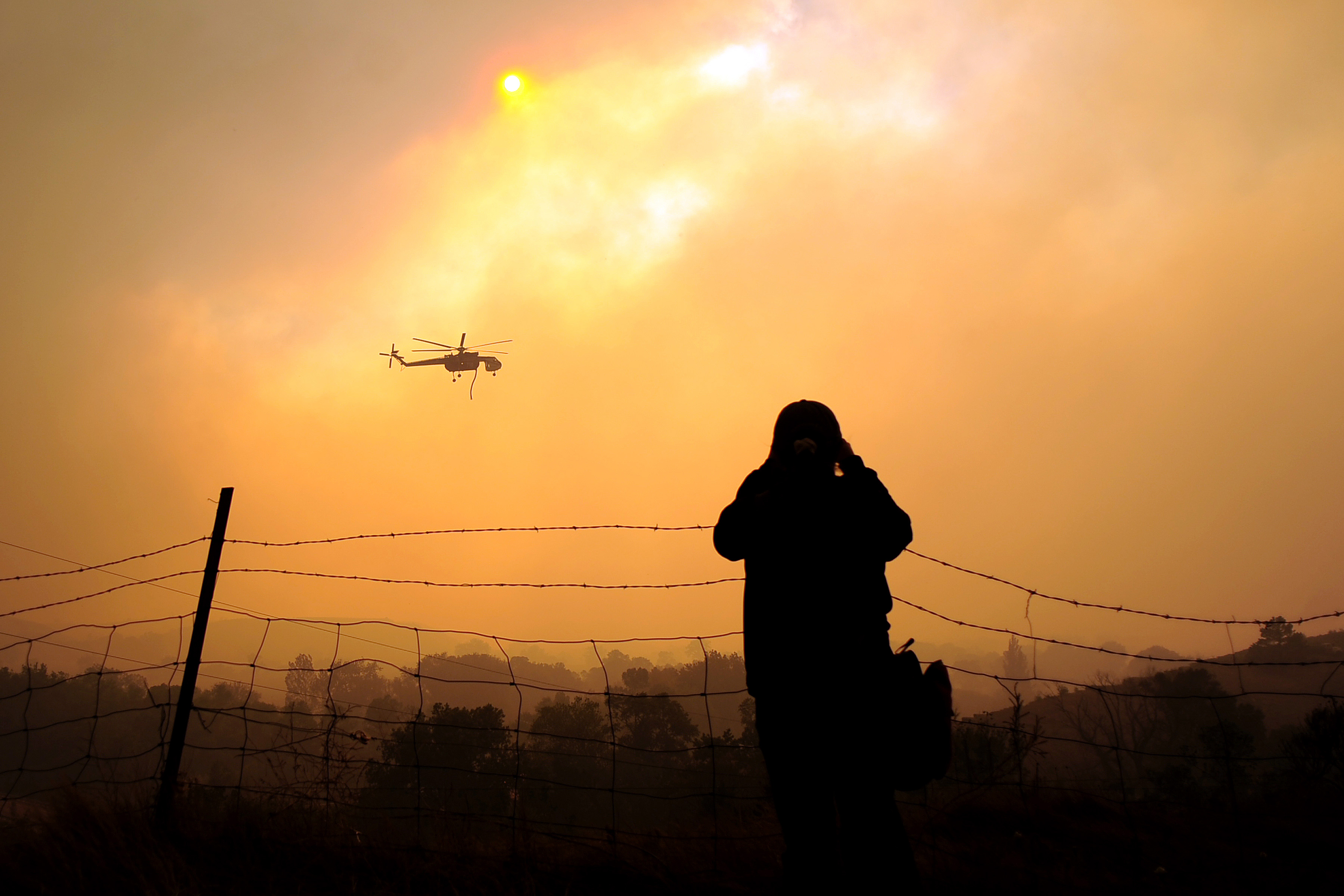 Crystal Foust watches from County Road 56 as a helicopter flies over a wildfire burning in a mountainous area about 15 miles west of Fort Collins, Colo. Firefighters are fighting wildfires that have spread quickly in parched forests in Colorado and New Mexico, forcing hundreds of people from their homes and the evacuation of wolves from a sanctuary.
Crystal Foust watches from County Road 56 as a helicopter flies over a wildfire burning in a mountainous area about 15 miles west of Fort Collins, Colo. Firefighters are fighting wildfires that have spread quickly in parched forests in Colorado and New Mexico, forcing hundreds of people from their homes and the evacuation of wolves from a sanctuary.BELLVUE, Colo. - Massive wildfires in drought-parched Colorado and New Mexico tested the resources of state and federal crews Monday and underscored the need to replenish an aging U.S. aerial firefighting fleet needed to combat a year-round fire season.
Wyoming diverted personnel and aircraft from two fires there to help with a 60-square-mile wildfire in northern Colorado. Canada also loaned two aerial bombers to fight the Colorado blaze following the recent crash of a U.S. tanker in Utah. And an elite federal firefighting crew arrived to try to begin containing a fire that destroyed at least 118 structures.
All told, about 600 firefighters will be battling the fire some 15 miles west of Fort Collins by Tuesday, said incident commander Bill Hahnenberg. "We are a very high priority nationally. We can get all the resources we want and need," he said.
But Colorado's House congressional delegation demanded that the U.S. Forest Service deploy more resources to the fire, which was zero percent contained and forced hundreds of people to abandon their homes. One person was missing.
In a letter to the Forest Service, Colorado's congressmen said the need for firefighting aircraft was "dire." Colorado U.S. Sen. Mark Udall urged President Barack Obama to sign legislation that would allow the Forest Service to contract at least seven large air tankers to add to its fleet of 13 - which includes the two on loan from Canada.
One of the region's most potent aerial firefighting forces - two Wyoming Air National Guard C-130s fitted to drop slurry - sat on a runway in Cheyenne, 50 miles north of the Colorado fire. The reason: The U.S. Forest Service, by law, cannot call for military resources until it deems that its fleet is fully busy. It also takes 36 hours to mobilize the crews and planes, officials said.
"They just haven't thrown the switch yet because they feel like there are adequate resources available," said Mike Ferris, a spokesman for the National Interagency Fire Center in Boise, Idaho.
Colorado was using five of 13 air tankers available nationally, said Forest Service spokesman Steve Segin.
Meanwhile, helicopters were used to suck water from a reservoir and drop it on nearby homes dangerously close to the flames.
Evacuees expressed gratitude for the help.
"They're doing the best they can," said Barb Hermsen as she watched a helicopter make daring raids through smoke and flame to protect homes. "We know how much they have to go through, and where they're going - man, it's crazy."
In New Mexico, firefighters got new air and ground support to battle a fast-moving wildfire that charred tens of thousands of acres and forced hundreds of residents to leave their homes in the southern part of the state.
Smoke filled the air in the mountain community of Ruidoso as evacuees gathered at a high school gymnasium to get an update on the lightning-sparked fire in the Sierra Blanca mountain range. The blaze exploded over the weekend and reached more than 54 square miles by Monday.
An estimated 35 structures have been damaged or destroyed by the blaze, and fire managers expect that number to grow once damage assessments are done.
Elsewhere in New Mexico, firefighters made slow progress against the largest wildfire in state history. The blaze has charred 435 square miles of forest since it was sparked by lightning in mid-May, and was 37 percent contained Monday.
Arizona's state forestry division dispatched two water tenders and 15 fire trucks to New Mexico, which also welcomed the arrival of a DC-10 jetliner that can lay a 100-yard-wide, mile-long line of retardant or water.
Fire bosses in New Mexico and Arizona ordered more elite crews, engines and air support from the Southwest Coordination Center in Albuquerque, where director Kenan Jaycox said resources are approaching full capacity.
"It's a balancing game," Jaycox said.
At least 18 large wildfires are burning in nine U.S. states, forcing the reshuffling of fire crews and aircraft. The National Interagency Fire Center in Boise, Idaho, said 4,000 of 15,000 federal firefighters are currently deployed at fires around the country.
Because aircraft were scarce, federal fire managers asked Wyoming to send National Guard helicopters to a 6-square-mile wildfire in Guernsey State Park. In nearby Medicine Bow National Forest, crews containing a 13-square-mile fire sent air support to Colorado.
U.S. Forest Service Chief Tom Tidwell has long insisted the federal government has enough resources to respond to a year-round wildfire season driven by drought, heat, decades of fighting forest fires rather than letting them run their natural course, and bark beetle pine tree kill.
"We have enough resources at this time to be able to deal with the fires we currently are dealing with and what we expect to have to deal with the rest of this fire season," Tidwell told The Associated Press last week. He emphasized that the forest service has the authority to transfer funds from other accounts to meet firefighting costs in any given year.
Some 1,459 square miles have burned across the country this year - less than the same period in 2011, when 6,327 square miles burned.
---
Associated Press writers Susan Montoya Bryan in Albuquerque, N.M.; Felicia Fonseca in Flagstaff, Ariz.; and Mead Gruver in Cheyenne, Wyo., contributed to this report.